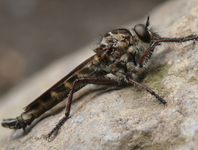Abstract
Rasbora neilgherriensis Day, long considered a synonym of Rasbora daniconius or Rasbora dandia, is re-described and shown to be a valid species based on an examination of type and recently-acquired topotypical specimens from the Western Ghats of India. The species is characterised by a complete lateral line with 32–34 pored scales on body, ½5–6/1/2½ scales in transverse line on body, a mid-lateral stripe that is 2½ scales wide anterior to the pelvic fin and 1–1½ scales wide on the caudal peduncle, and a caudal fin that is emarginate to forked with broadly rounded lobes. The species was recorded from the Cauvery River Basin in Kerala and Tamil Nadu, India, at elevations ranging from 710 m to 2015 m above sea level, in stream stretches with relatively denser riparian canopy cover.
References
Brittan, M.R. (1954) A revision of the Indo-Malayan fresh-water fish genus Rasbora. Monographs of the Institute of Science and Technology, Manila, 3, 1–224, maps 1–3.
Day, F. (1867) On the fishes of the Neilgherry Hills and rivers around their bases. Proceedings of the Zoological Society of London, 2, 281–302.
Day, F. (1871) Monograph of Indian Cyprinidae. Journal of the Royal Asiatic Society of Bengal, 40 (2), 277–336. pl. 9, 21–23.
Day, F. (1878) The fishes of India; being a natural history of the fishes known to inhabit the seas and fresh waters of India, Burma, and Ceylon. Vol.1. Bernard Quaritch, London, 778 pp.
https://doi.org/10.5962/bhl.title.62705
Fricke, R., Eschmeyer, W.N. & Van der Laan, R. (2020) Eschmeyer’s catalog of fishes: genera, species, references. Available from: http://researcharchive.calacademy.org/research/ichthyology/catalog/fishcatmain.asp.(accessed 30 July 2020).
Hora, S.L. (1937) Notes on fishes in the Indian Museum, XXVIII. On three collections of fish from Mysore and Coorg, South India. Records of the Indian Museum, 39 (1), 5–28.
Hora, S.L. & Mukerji, D.D. (1935) Notes on fishes in the Indian Museum, XXV. On two new species of Cyprinid fishes from Deolali, Nasik District, Bombay Presidency. Records of the Indian Museum, 37 (3), 375–380
Jayaram, K.C. (1981) The freshwater fishes of India, Pakistan, Bangladesh, Burma and Sri Lanka- a handbook. Zoological Survey of India, Calcutta, 511 pp.
Jayaram, K.C., Venkateswarlu, T. & Ragunathan, M.B. (1982) A survey of the Cauvery River with a major account of its fish fauna. Records of the Zoological Survey of India Occasional Paper, 36, 1–115, pls. 1–12.
Lumbantobing, D.N. (2010) Four new species of the Rasbora trifasciata- group (Teleostei: Cyprinidae) from Northwestern Sumatra, Indonesia. Copeia, 4, 644–670.
https://doi.org/10.1643/CI-09-155
Menon, A.G.K. (1999) Check list—Fresh water fishes of India. Records of the Zoological Survey of India Occasional Paper, 175, 1–366.
Silva, A., Maduwage, K. & Pethiyagoda, R. (2010) A review of the genus Rasbora in Sri Lanka, with description of two new species (Teleostei: Cyprinidae). Ichthyological Exploration of Freshwaters, 21 (1), 27–50.
Sudasinghe, H., Pethiyagoda, R., Ranasinghe, R.H.T., Raghavan, R., Dahanukar, N. & Meegaskumbura, M. (2020) A molecular phylogeny of the freshwater-fish genus Rasbora (Teleostei: Cyprinidae) in Sri Lanka reveals a remarkable diversification and a cryptic species. Journal of Zoological Systematics and Evolutionary Research, 2020, 1–35.


